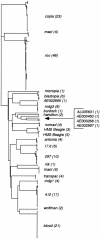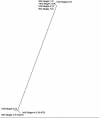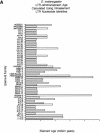Drosophila euchromatic LTR retrotransposons are much younger than the host species in which they reside
- PMID: 11544196
- PMCID: PMC311128
- DOI: 10.1101/gr.164201
Drosophila euchromatic LTR retrotransposons are much younger than the host species in which they reside
Abstract
The recent release of the complete euchromatic genome sequence of Drosophila melanogaster offers a unique opportunity to explore the evolutionary history of transposable elements (TEs) within the genome of a higher eukaryote. In this report, we describe the annotation and phylogenetic comparison of 178 full-length long terminal repeat (LTR) retrotransposons from the sequenced component of the D. melanogaster genome. We report the characterization of 17 LTR retrotransposon families described previously and five newly discovered element families. Phylogenetically, these families can be divided into three distinct lineages that consist of members from the canonical Copia and Gypsy groups as well as a newly discovered third group containing BEL, mazi, and roo elements. Each family consists of members with average pairwise identities > or =99% at the nucleotide level, indicating they may be the products of recent transposition events. Consistent with the recent transposition hypothesis, we found that 70% (125/178) of the elements (across all families) have identical intra-element LTRs. Using the synonymous substitution rate that has been calculated previously for Drosophila (.016 substitutions per site per million years) and the intra-element LTR divergence calculated here, the average age of the remaining 30% (53/178) of the elements was found to be 137,000 +/-89,000 yr. Collectively, these results indicate that many full-length LTR retrotransposons present in the D. melanogaster genome have transposed well after this species diverged from its closest relative Drosophila simulans, 2.3 +/-.3 million years ago.
Figures








Similar articles
-
Structural and evolutionary analyses of the Ty3/gypsy group of LTR retrotransposons in the genome of Anopheles gambiae.Mol Biol Evol. 2005 Jan;22(1):29-39. doi: 10.1093/molbev/msh251. Epub 2004 Sep 8. Mol Biol Evol. 2005. PMID: 15356275
-
Recent LTR retrotransposon insertion contrasts with waves of non-LTR insertion since speciation in Drosophila melanogaster.Proc Natl Acad Sci U S A. 2007 Jul 3;104(27):11340-5. doi: 10.1073/pnas.0702552104. Epub 2007 Jun 25. Proc Natl Acad Sci U S A. 2007. PMID: 17592135 Free PMC article.
-
Amplification of the 1731 LTR retrotransposon in Drosophila melanogaster cultured cells: origin of neocopies and impact on the genome.Gene. 2007 May 15;393(1-2):116-26. doi: 10.1016/j.gene.2007.02.001. Epub 2007 Feb 16. Gene. 2007. PMID: 17382490
-
Mechanisms of LTR-Retroelement Transposition: Lessons from Drosophila melanogaster.Viruses. 2017 Apr 16;9(4):81. doi: 10.3390/v9040081. Viruses. 2017. PMID: 28420154 Free PMC article. Review.
-
LTR-retrotransposons in plants: Engines of evolution.Gene. 2017 Aug 30;626:14-25. doi: 10.1016/j.gene.2017.04.051. Epub 2017 May 2. Gene. 2017. PMID: 28476688 Review.
Cited by
-
The nature and genomic landscape of repetitive DNA classes in Chrysanthemum nankingense shows recent genomic changes.Ann Bot. 2023 Feb 7;131(1):215-228. doi: 10.1093/aob/mcac066. Ann Bot. 2023. PMID: 35639931 Free PMC article.
-
Copia retrotransposon in the Zaprionus genus: another case of transposable element sharing with the Drosophila melanogaster subgroup.J Mol Evol. 2011 Mar;72(3):326-38. doi: 10.1007/s00239-011-9435-6. Epub 2011 Feb 24. J Mol Evol. 2011. PMID: 21347850
-
Evolution of genome structure in the Drosophila simulans species complex.Genome Res. 2021 Mar;31(3):380-396. doi: 10.1101/gr.263442.120. Epub 2021 Feb 9. Genome Res. 2021. PMID: 33563718 Free PMC article.
-
Dispersal from the Qinghai-Tibet plateau by a high-altitude butterfly is associated with rapid expansion and reorganization of its genome.Nat Commun. 2023 Dec 11;14(1):8190. doi: 10.1038/s41467-023-44023-2. Nat Commun. 2023. PMID: 38081828 Free PMC article.
-
Dynamic interactions between transposable elements and their hosts.Nat Rev Genet. 2011 Aug 18;12(9):615-27. doi: 10.1038/nrg3030. Nat Rev Genet. 2011. PMID: 21850042 Free PMC article. Review.
References
-
- Adams MD, Celniker SE, Holt RA, Evans CA, Gocayne JD, Amanatides PG, Scherer SE, Li PW, Hoskins RA, Galle RF, et al. The genome sequence of Drosophila melanogaster. Science. 2000;287:2185–2195. - PubMed
-
- Baldrich E, Dimitri P, Desset S, Leblanc P, Codipietro D, Vaury C. Genomic distribution of the retrovirus-like element ZAM in Drosophila. Genetica. 1997;100:131–140. - PubMed
Publication types
MeSH terms
Substances
LinkOut - more resources
Full Text Sources
Molecular Biology Databases
